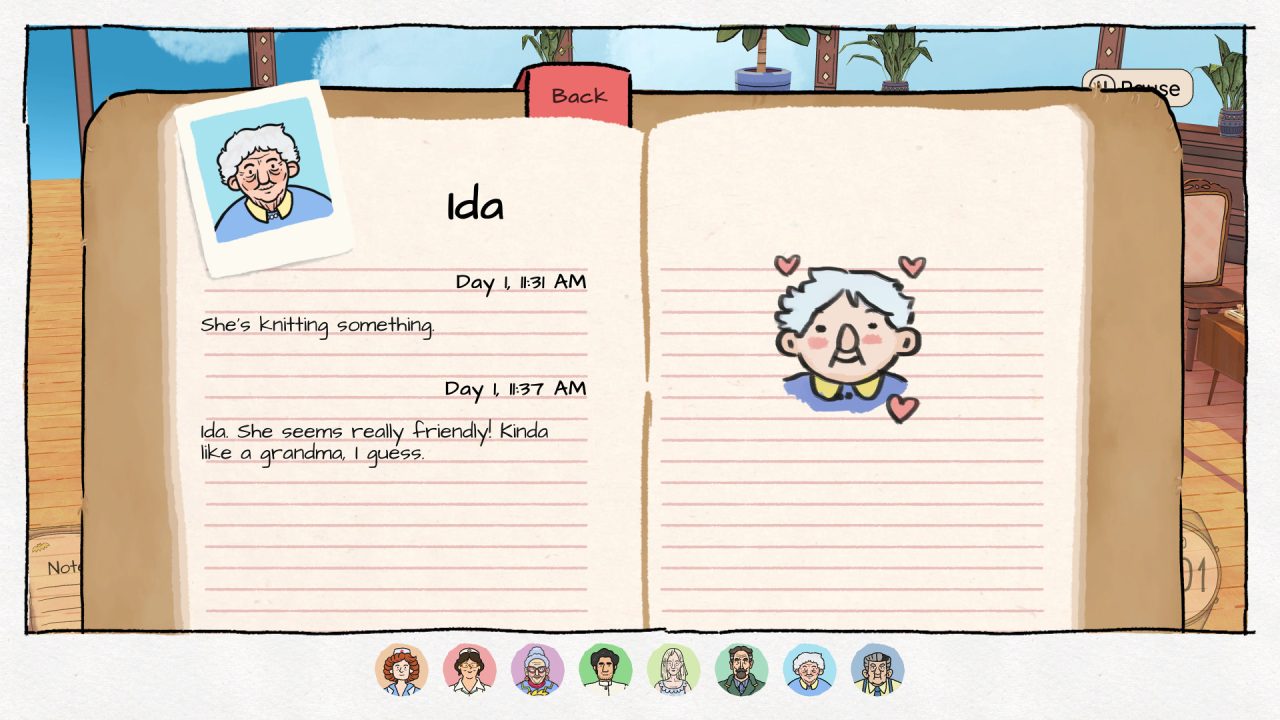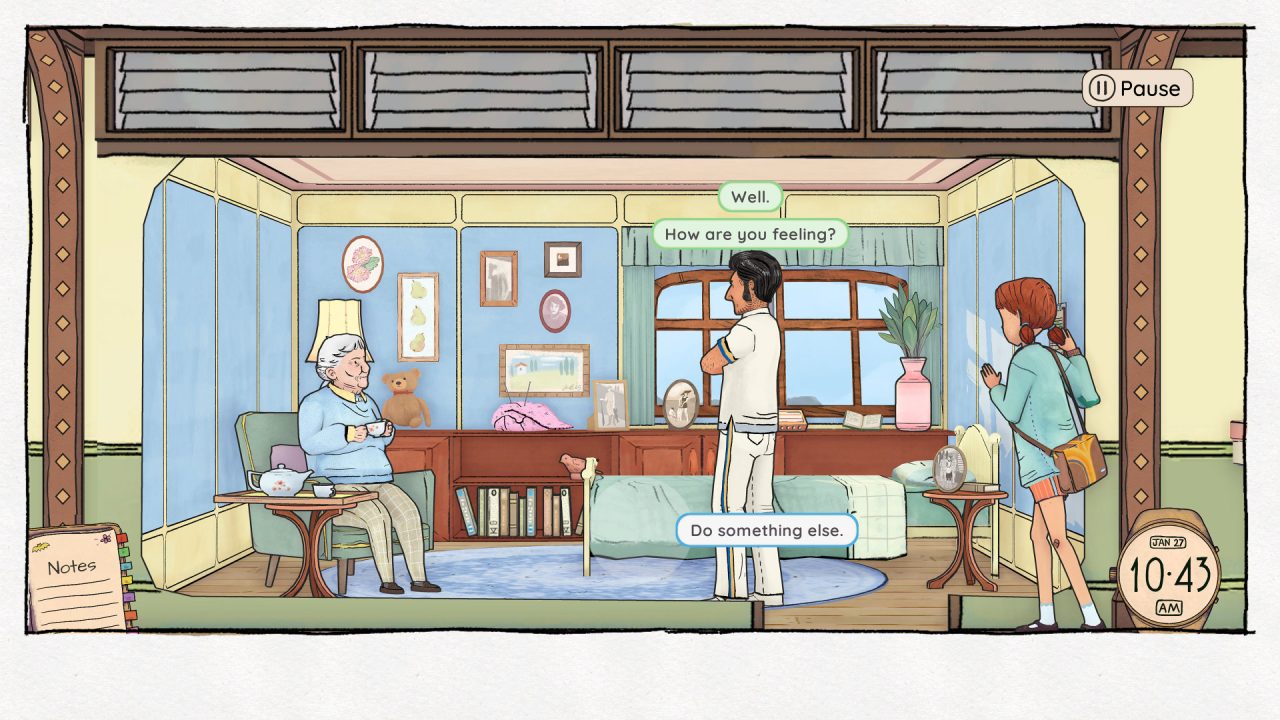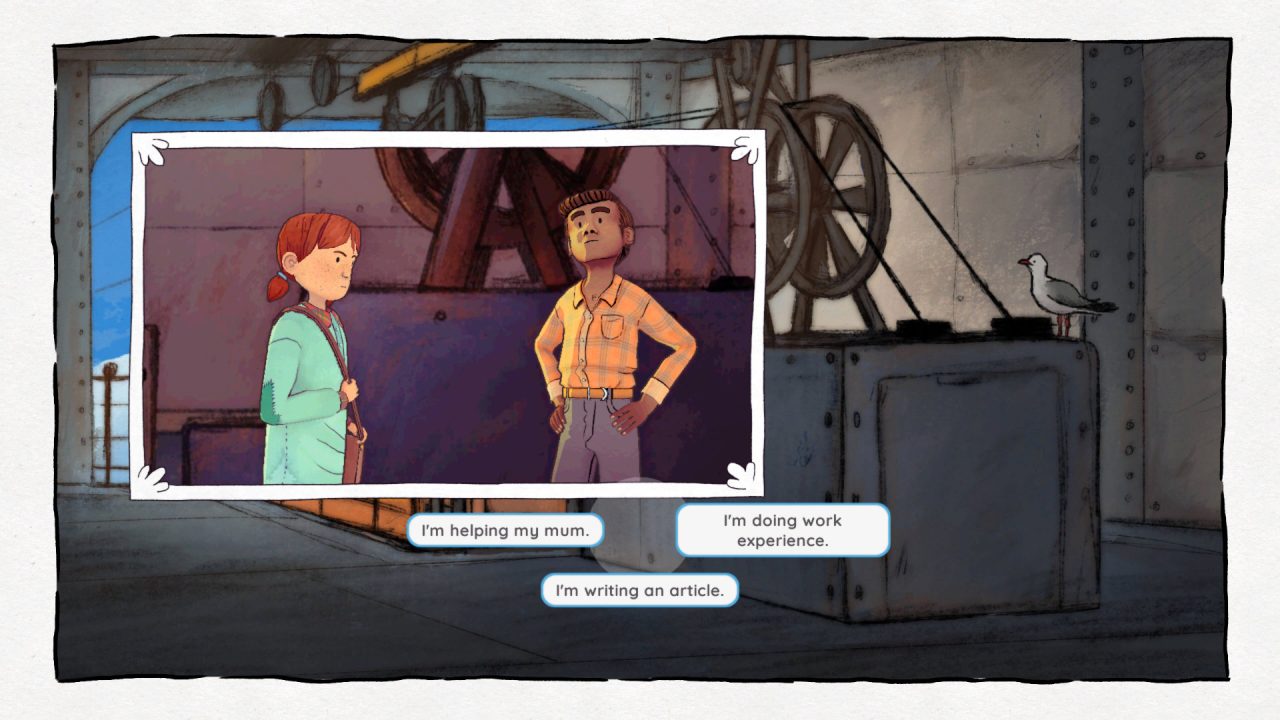Pulling at loose threads can cause an entire piece of clothing to unravel. Similarly, Ghost Pattern‘s graphic adventure title Wayward Strand has a central theme with numerous “loose” narrative threads. You have to gently pull at each thread to reveal the game’s plot in its entirety, in what is ultimately a touchingly tender gaming experience.
The year is 1978. During her school holiday, fourteen-year-old Casey is roped by her mum into helping out at the airship-turned-floating-hospital where she works as the head nurse. Casey’s job? Assist the nurses and visit as many of the hospital’s patients as she can over the course of three days. Being an aspiring journalist for her school paper, young Casey also brings her trusty notebook with her in the hopes that she can compile enough information to write an article about the hospital.
The crux of Wayward Strand‘s gameplay involves gathering information about the airship itself and its residents and using said information to potentially assist others. As a child herself, Casey (understandably) can’t help with the myriad medical care issues at hand, but she can provide a helpful ear to those in need, even if they might not realize it at the time. Her inquisitive nature can annoy to some of the more taciturn or private patients, while others are more than willing to share information about their lives depending on the situation. Every person in the hospital has their own preferences as to how interactions should go, and you uncover those preferences the more time you spend with each person.

Spending time is another interesting feature of Wayward Strand, as you only have three days to work with, and the game features real-time progression. You choose who to spend moments with, but events with the other residents are still ongoing as you do. Nurses and patients traverse the halls as you’re talking with someone, and characters will change what they’re doing depending on the time of day, potentially opening up new story routes. It makes for an intriguing mechanic, as you must pick and choose what events you’d prefer to see, and act accordingly. There is no way to view every story scene in a single playthrough with how Wayward Strand is set up, encouraging multiple playthroughs if you wish to uncover how all of the branching points develop. It’s a realistic detail, causing you to carefully consider how to spend your time, providing a sense of reality with a world that remains in motion even when your character isn’t actively participating in it.
As Casey, you wander the hospital’s halls and can visit patients in their rooms, depending on the time of day and what a given patient is doing. Choosing to stay in a room for a while will provide you with options such as perusing the info Casey has written down in her notebook based on things you have witnessed and learned, attempting to strike up a conversation, or even just hanging out with the patient in comfortable silence. While that third option might seem like a waste of time, sitting quietly with someone can often lead them to eventually broaching a topic themselves, offering further insight into their mindsets or what is going on in their lives. During questioning, you even have the option to drop subjects, which might prove beneficial if a patient is reticent about discussing a topic further. The sheer amount of interaction dialogue options you have depending on the situation and what is happening around the hospital at any given time is impressive.

In addition to visiting patients in their rooms, you can peek into more private interactions amongst people or listen in to conversations at specific points to help gather information. Other avenues include offering assistance in gathering materials for patients or the overworked nurses, and ordering lunch to enjoy with patients for further conversation prompts. You also can have Casey sit down and relax or read in certain areas of the hospital, which might cause a scene to play out if someone else decides to do the same thing at that time. It all depends on what is going on at a given moment within the game’s world.
Because you’re going from person to person throughout the hospital setting, there is a sense of Wayward Strand being a collection of smaller stories that forms a larger whole. Yes, an overreaching plot involving the hospital staff being overworked permeates the three days and strains Casey’s relationship with her stretched-thin mother. Still, even those plot threads are ones that you-as-Casey only uncover bits and pieces of unless you focus more of your time on those portions of the plot. The real strength and charm of the narrative are in how multi-layered and nuanced the characters are. Everyone has their own stories playing out in the background, such as the elderly and slow-talking Mr. Pruess, the angry and terminally ill Dr. Bouchard, the creative-minded Mr. Avery, the gentle Ida, the young shuttle pilot Ted, and the kind-yet-overworked nurse Lily. Depending on your actions, you can choose to further play a part in these characters’ lives. I enjoyed developing Casey’s friendship with Ted and having her learn about his Aboriginal culture as they bonded over comics and the airship itself, and Mr. Pruess’ patient conversations with the more inquisitive side of Casey’s nature and reminiscences pulled at my heart. Mr. Avery and Ida’s friendships with Esther and Tomi were wonderful to see through Casey’s eyes as she learned more about all four patients together and on her own. Even the little insights you see about the recently departed Mr. Falk through helping to gather his things and talking about him with the other residents reveals a touching story of a life that was well-lived. You come to care for the characters even when some spurn Casey due to their personal trials, and it is a testament to the game’s writing that I wanted to be able to spend more time with each and every one of them. There is a calming softness to how things play out in this game, a tenderness that can bring both ache and warmth to your heart in equal measure, depending on how you view things. It’s truly lovely.

The game’s graphics are colorful but muted to help convey the quiet softness of a hospital setting, with a hand-drawn look reminiscent of a comic or cartoon. I love the UI and how the dialogue boxes look, and the little doodles Casey adds to her notebook findings are adorable. Each character has a standout and memorable design. The game is fully voice-acted, and the actors read their lines perfectly: conveying every slight nuance and emotion throughout their deliveries. The music is subtle and has a patient, soothing quality fitting for a hospital setting. I especially loved the option to include audio descriptions for sound effects that Wayward Strand helpfully provides. Every little moment in the script, both involving Casey and not, flows naturally and believably throughout the days, truly giving you a sense of the characters living their lives as you progress.
There isn’t much I can honestly fault Wayward Strand for. I did notice at least two incidents where I was prompted to do something by a character, and I couldn’t instigate the next part of the request. For example, I never saw certain outcomes, such as finding a cushion for Esther or asking Mr. Pruess about his conversation with the hospital director at Dr. Bouchard’s behest. I think the real-time progression might not be to everyone’s preference if they don’t want to replay the game. However, Wayward Strand is short enough that I didn’t find it horribly detrimental, either. Since there is no option to save manually, the game will auto-save after each day segment, and that can be slightly frustrating if you’ve only a limited amount of time to play. But, given the title’s shorter length, I still don’t consider this more than a mild annoyance.
Wayward Strand is a heartfelt, touching story that grows on you the more you play it. I found myself caring a lot about Casey and the people she encountered at the hospital, and I started thinking about what I might uncover the next time I played the game the second I completed my first playthrough. That, to me, makes the title a success! I love the messages the story conveys, and the amount of care and thought that was clearly put into it. Wayward Strand is a feels-inducing, gentle sort of tale. For those looking for that type of story, Wayward Strand should not be missed!



